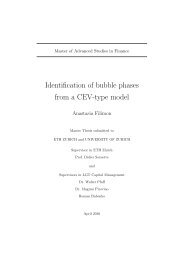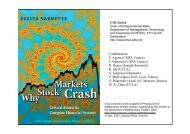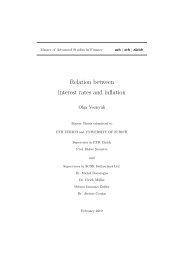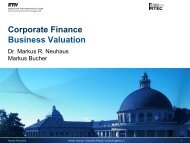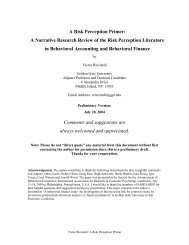Tail Dependence - ETH - Entrepreneurial Risks - ETH Zürich
Tail Dependence - ETH - Entrepreneurial Risks - ETH Zürich
Tail Dependence - ETH - Entrepreneurial Risks - ETH Zürich
Create successful ePaper yourself
Turn your PDF publications into a flip-book with our unique Google optimized e-Paper software.
4.4 Assets included in indexes ’MERVAL’, ’MIBTEL’, ’NASDAQ’, and ’SMI’<br />
that were used for the implementation of the different concepts given by<br />
their name, further used abbreviation, and country of origin. . . . . . . 133<br />
4.5 Assets included in indexes ’S&P 500’, ’SSEC’, and ’TA 100’ that were<br />
used for the implementation of the different concepts given by their name,<br />
further used abbreviation, and country of origin. Additional assets included<br />
in index S&P 500 that were not part of the reference samples<br />
presented in chapter (3) are listed below ’new assets’. . . . . . . . . . . 134<br />
4.6 Estimated upper and lower tail dependence ˆ λ +,− applying the non-parametric<br />
and parametric approaches according to Sornette & Malevergne to index<br />
S&P 500 and 16 assets included in dependence of their component<br />
weights in the index denoted by ’C.W.’ and β. The data samples contain<br />
N = 2000 daily price observations on a range from 12.04.2000 to<br />
31.03.2008. <strong>Tail</strong> index ˆν was calculated using Hill’s estimator, k =<br />
0.04 · N = 80, c = 0.005 · N = 10, and ∗ denotes negative ˆ β. . . . . . . 135<br />
4.7 Estimated upper and lower tail dependence ˆ λ +,− applying the non-parametric<br />
approach according to Sornette & Malevergne to index S&P 500 and 16<br />
assets included using βSI only calculated for the extreme tails by first<br />
and second β-smile conditions. Component weights of assets within the<br />
index are denoted by ’C.W.’, βSI for the first and second conditions and<br />
β calculated for all data are listed to observe their impact on the estimates.<br />
The data samples contain N = 2000 daily price observations on a<br />
time interval from 12.04.2000 to 31.03.2008. <strong>Tail</strong> index ˆν was calculated<br />
using Hill’s estimator. ’Cond 1’ denotes: Y ≥ Y (k) ∩ X ≥ X(k), ’Cond.<br />
2’ denotes Y ≥ Y (k), k = 0.04 · N = 80, c = 0.005 · N = 10, and ∗<br />
denotes negative ˆ β. . . . . . . . . . . . . . . . . . . . . . . . . . . . . . 136<br />
4.8 Estimated upper and lower tail dependence ˆ λ +,− applying the parametric<br />
and the non-parametric approach according to Sornette & Malevergne<br />
to index Dow Jones Industrial Average and 12 assets included using β<br />
calculated by all data. Component weights of assets within the index<br />
are denoted by ’C.W.’, and β calculated for all data are listed to observe<br />
their impact on the estimates. The data samples contain N = 2000 daily<br />
price observations on a time interval from 16.08.2000 to 31.07.2008. <strong>Tail</strong><br />
index ˆν was calculated using Hill’s estimator, k = 0.04 · N = 80, and<br />
c = 0.005 · N = 10. . . . . . . . . . . . . . . . . . . . . . . . . . . . . . 137<br />
4.9 Estimated upper and lower tail dependence ˆ λ +,− applying the non-parametric<br />
approach according to Sornette & Malevergne to index Dow Jones Industrial<br />
Average and 12 assets included using βSI only calculated for<br />
the extreme tails by first and second β-smile conditions. Component<br />
weights of assets within the index denoted by ’C.W.’, βSI for the first<br />
and second conditions and β calculated for all data are listed to observe<br />
their impact on the estimates. The data samples contain N = 2000 daily<br />
price observations on a time interval from 16.08.2000 to 31.07.2008. <strong>Tail</strong><br />
index ˆν was calculated using Hill’s estimator, k = 0.04 · N = 80, and<br />
c = 0.005 · N = 10. . . . . . . . . . . . . . . . . . . . . . . . . . . . . . 138



